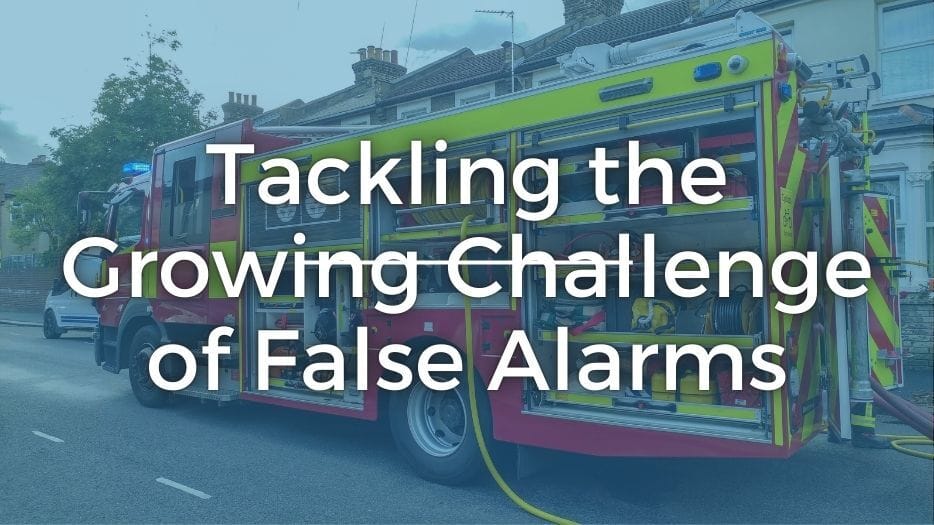Tackling the Growing Business Challenge of False Alarms

False alarms aren’t just irritating. They disrupt your team, dent your reputation and eat into your profits. Worse still, they can cause you to lose your emergency response, damage customer confidence and even invalidate your insurance.
Let’s break this down. Because fire alarm and intruder alarm false activations both carry risks – but the fix is well within your control.
False Fire Alarms: Avoiding Unnecessary Evacuations & Charges
False alarms from fire systems are one of the biggest causes of business disruption.
Just 10 false alarms a year and the London Fire Brigade will charge you £290 + VAT every time. In other regions, you can be charged after just four.
And across the UK, fire services are tightening their policies:
East Sussex Fire & Rescue Service will no longer automatically attend fire alarms in low-risk commercial buildings (like offices and schools) unless a fire is confirmed by phone.
You could also face:
Lost productivity from repeated evacuations
Staff becoming complacent during genuine emergencies
Damaged customer confidence and wasted site access time
It’s advisable for businesses everywhere to maintain fire alarm systems properly and ensure staff are well-trained to minimise false activations and avoid the serious consequences.
Strategies For Minimising False Fire Alarm Occurrences
Reducing false fire alarms isn’t about a single fix – it requires a joined-up approach that combines better technology, maintenance and staff awareness.
Here are four essential steps:
- Upgrade to Dual-Sensor Fire Alarms with Smart Verification
Why it matters: Traditional alarms can be triggered by steam, dust or aerosols. Dual-sensor systems (using both ionisation and photoelectric sensors) are better at distinguishing real smoke from false triggers.
Smart verification goes further: some systems require confirmation from multiple sensors, or use AI to assess the nature of the threat before sounding the alarm.
Result: Fewer unnecessary evacuations and a more reliable fire detection setup
- Carry Out Monthly System Tests and Regular Maintenance
Why it matters: Many false alarms stem from neglected maintenance. Dust, insects, wiring faults or outdated equipment can all contribute.
Action: Schedule and document monthly checks. This keeps your system in peak condition and helps spot problems before they cause disruption. - Train All Staff in How and When to Activate Fire Systems
Why it matters: Human error is one of the most common causes of false alarms – especially accidental use of manual call points.
Action: Build fire system awareness into staff inductions, and offer refresher training regularly. The better your team understands the system, the fewer mistakes you’ll see. - Document Incidents Properly to Track and Reduce Repeat Triggers
Why it matters: False alarms often follow patterns – like a specific detector triggering at the same time each week. But without records, it’s easy to miss.
Action: Keep a clear log of each incident. Use the data to guide maintenance, system tweaks or targeted training.
Combining technology upgrades, regular maintenance, staff training and incident tracking is the most effective way to cut false fire alarms.
It’s not just about compliance – it's about protecting your people, maintaining productivity and making sure the fire brigade responds when it really matters.
Choosing a BAFE-certified provider like Armoury Security + Fire ensures your fire alarm systems meet rigorous national standards – and gives you confidence that both installation and ongoing servicing are being handled correctly.
False Intruder Alarms: Don’t Risk Losing Police Response
When an intruder alarm goes off without reason, it's more than annoying: it could cost you your police response entirely.
More than 3 false alarms per year can result in the suspension of your URN (Unique Reference Number) – meaning police may no longer attend when you really need them.
The risks?
No response to break-ins
Increased insurance premiums
Potential refusal of cover altogether
Avoid losing your URN through false alarms by:
Dual-Path Signalling and Video Verification
Why it matters: Dual-path signalling uses two independent communication routes (such as mobile and landline) to ensure signals always reach your monitoring centre. This reduces the risk of false dispatches caused by signal loss or delays.
Video or audio verification adds another layer: control room operators can assess whether an activation is real before notifying the police, significantly cutting down false alarms.
Maintain Systems to NSI Gold or SSAIB Standards
Why it matters: Both NSI Gold and SSAIB certified companies meet strict British and European standards for alarm system design, installation and maintenance.
Certification to either standard ensures your provider is regularly audited and compliant with key standards like BS 8243:2021, which is specifically focused on reducing false alarms and confirming genuine intrusions.
By working with a certified provider, you're far more likely to avoid technical faults or user errors – and to maintain your eligibility for police response through a valid URN.
Train Staff on Set/Unset Procedures
Why it matters: Many false alarms are simply caused by incorrect use of the system – such as failing to disarm it properly.
Training staff on correct procedures, assigning individual user codes and ensuring clear instructions are in place can make a huge difference.
Keep Accurate Incident Logs
Why it matters: Without proper records, it’s hard to spot trends. Are the same users triggering alarms? Is a particular sensor faulty?
Keeping detailed logs of all alarm events helps identify patterns, guide improvements and support compliance with police and insurance expectations.
Modern intruder alarm systems are highly reliable – but only if used and maintained correctly. Combine smart verification, NSI Gold/SSAIB oversight, proper training and logging for a proactive approach that protects your premises without unnecessary disruptions.
Maintaining Police Response in East Sussex
If your business is based in East Sussex, you fall under the jurisdiction of Sussex Police – and maintaining police response for your intruder alarm system requires careful attention.
While specific local policies aren’t publicly detailed, Sussex Police follow national guidelines that allow for the withdrawal of police response after multiple false alarms. Typically, police response can be suspended:
- After three false alarms per year for systems without confirmed verification
- After five false alarms for systems with enhanced confirmation methods
To reduce the risk of losing police support, ensure your alarm system is maintained to the highest standards and operated correctly.
Top tips for East Sussex businesses:
- Use confirmed alarm systems with video or dual verification
- Partner with an NSI Gold or SSAIB certified provider
- Keep up with regular servicing and updates
- Train all users on correct setting/unsetting procedures
- Maintain detailed incident logs to spot recurring issues
By taking these steps, you’ll not only reduce false alarms – you’ll keep your URN active and ensure that Sussex Police are still available when a real emergency happens.
Impact On Emergency Services And Response Times
False alarms don’t just affect your business – they have a serious knock-on effect on our emergency services.
When fire crews or police are called out for a false activation, they’re diverted from real emergencies where lives or property might be at risk. And over time, repeated false callouts erode trust in your site’s reliability.
The consequences?
Delayed response times for genuine emergencies – sometimes by 20 minutes or more
Lower morale among responders, who are pulled away from critical incidents
Increased risk to the public, especially if false calls become routine in a given area
The average false alarm costs the public purse over £300 in wasted resource and logistics. Multiply that across hundreds of businesses and you see why the tolerance for repeat activations is so low.
That’s why fire services charge and police services withdraw URNs – it’s about ensuring real emergencies get the fast, focused response they deserve.
You’ll not only protect your business by acting – you’ll also help emergency teams do their jobs more effectively.
Modern Solutions And Technological Advancements
Modern alarm systems are a world away from their predecessors.
Thanks to AI-powered analytics, dual verification and mobile monitoring, businesses now have the tools to drastically reduce false activations.
Here’s how tech helps:
Smart sensors distinguish between real threats and harmless activity
Video verification confirms incidents before emergency dispatch
Mobile apps let you manage and assess activations instantly
By using the right technology, you gain peace of mind and stay on the right side of regulations and emergency services.
Time To Take Control Of The False Alarm Problem
False alarms are more than a nuisance. They can cost you time, money, compliance... even the attendance of the fire brigade, police response and your insurance cover.
But it doesn’t have to be that way.
Investing in better technology, training and maintenance means fewer disruptions, happier staff and stronger emergency service relationships.
Take action today and put false alarms behind you. Your business, your reputation and your bottom line will thank you.
Although we make reasonable efforts to update the information on our site, we make no representations, warranties or guarantees, whether express or implied, that the content on our site is accurate, complete or up to date.




